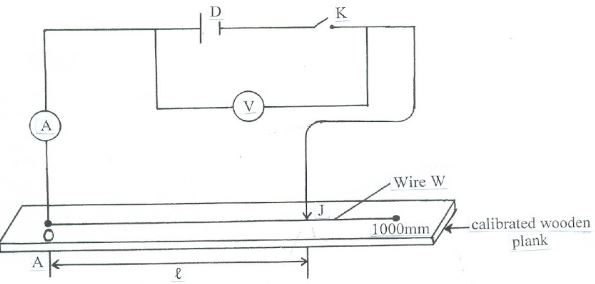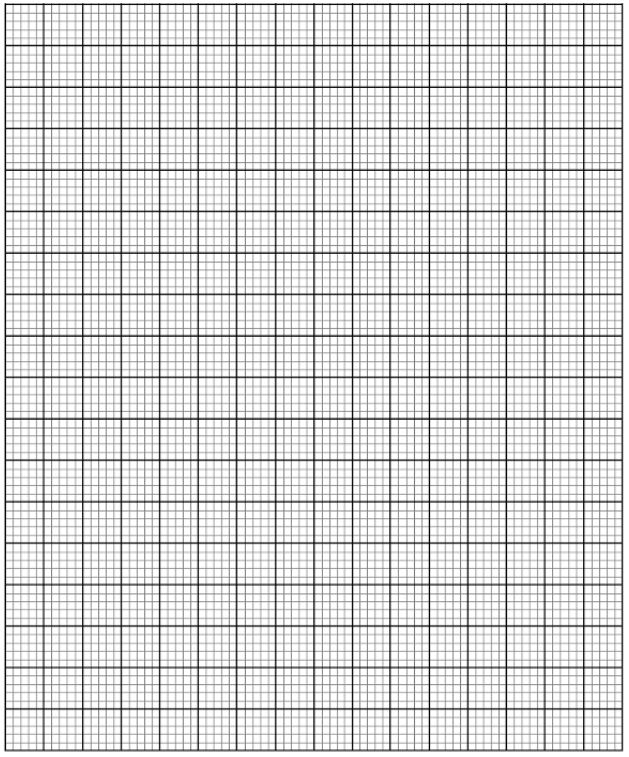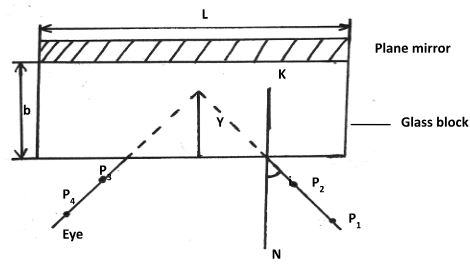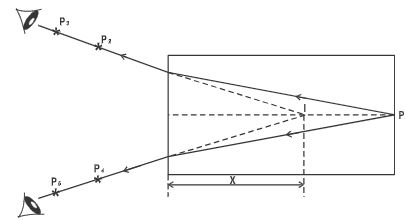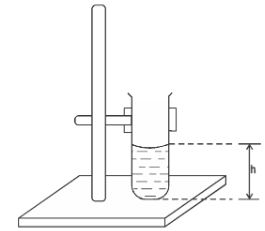INSTRUCTIONS TO CANDIDATES:-
- You are supposed to spend the first 15 minutes of 2 ½ hours reading the whole paper carefully before commencing your work.
- Marks are given for a clear record of the observations actually made, their suitability, accuracy and the use of them
- Record your observations as soon as you make them.
- Mathematical tables, slide rules and silent non-programmable electronic calculators may be used.
Take g = 10ms-2
QUESTION 1
- You are provided with the following/.
- A new size D dry cell 1.5V in a cell holder
- A voltmeter (Range 0 – 2.5V or 0 – 3.0V)
- An ammeter (Range 0 – 1.0A)
- A Constantine wire, W, mounted on a millimeter scale on a wooden plank
- 7 connecting wires with at least one with a crocodile clip at one end
- A micrometer screw gauge (to be shared)
- A switch
Proceed as follows:-
- Measure the thickness, t, in meters of the wire, W,
t = __________________________________ (1mark) - Connect the circuit as shown in the diagram below.
NB: Ensure the circuit is complete before commencing the experiment. The switch K should control both circuits.
- Measure the thickness, t, in meters of the wire, W,
- Starting with the crocodile clip, J, at L = 200mm from A, close the switch K and record the voltmeter reading V and the corresponding ammeter reading I.
- Voltmeter reading, V = ____________________________ (1mark)
- Ammeter reading, I = ____________________________ (1mark)
NOTE
Open the switch, K, when not taking the readings
-
- Repeat the procedure in (b) above for values of (L= 300, 400, 500, 600 and 800mm.
- Record your results in the table below (5 marks)
Length (AJ) L(mm) 200 300 400 500 600 700 Voltmeter reading V(V) Ammeter reading, I(A) V/I
- Plot a graph of the voltmeter reading, V/I, (vertical axis) against Length L (m). (5marks)
- From your graph;
- Determine the slope, S, (3marks)
- Now connect the voltmeter across the wire, W, to enable you obtain a potential drop across any part of length, AJ, of the wire, W
- Using the length, AJ, = L = 550mm, close the switch and then read the voltmeter and corresponding ammeter readings.
Voltmeter reading, V = ____________V (1 mark)
Ammeter reading, I = _____________A (1 Mark)
- Using the length, AJ, = L = 550mm, close the switch and then read the voltmeter and corresponding ammeter readings.
- Calculate the value of P from
P = 0.785 Vt2
I L
Where L, V, t and I are quantities obtained in their SI units. (2marks)
-
QUESTION 2 PART A
You are provided with the following
- Rectangular glass block
- Five optical pins
- Half meter Rule
- Soft board
- Two sheets of Plain papers
- Plane mirror
- Cello tape
- Vernier calipers (to be shared)
- Four Thumb tacks or office pins
Set up the apparatus as shown in figure below
Proceed as follows-
- Using the vernier calipers provided, measure and record the breadth b of the glass block
b =__________________________cm (1 mark) - Trace the outline of the glass block on the plain sheet of paper (mounted on the soft board using office pins or thumb tacks). Using cello tape, fix the mirror on one side along the length of the glass block.
- Draw the normal NK on the plane paper along the outline as shown in the diagram and measure angle i = 20° from the normal
- Draw the line representing the incident ray and fix pins P1 and P2 as shown in the figure
- By observing the images of the pins P1 and P2, fix P3 and P4 such that they appear to be in a straight line with the images of P1 and P2 as seen in the glass block.
- Join the points P3 and P4 and extend them to intersect line P1 P2 produced. Measure the perpendicular distance Y
- Repeat steps (iii to vi) for different values of i given and record your values in the table below 2mks
i° 22 25 30 35 Y(cm) - Determine the average of the values of Y (2 marks)
- Determine the values of constant k given that (2marks)
- Using the vernier calipers provided, measure and record the breadth b of the glass block
- Measure the length, l, of the glass block using a half meter rule
l = ............................. cm (1 mark) - Place the glass block on the second plain sheet of paper (mounted on the soft board using office pins or thumb tacks) and trace its outline.
- Fix a pin P1 firmly at the middle of one end of the glass block as shown in figure below.
- With your eye at the opposite end of the block, place pins P2 and P3 so that they are in line with the image I of pin P1 as shown in the figure above. Similarly locate the image I using pins P4 and P5.
- Remove the glass block and produce P3P2 and P5P4 to their point of interaction.
-
- Measure the distance, x, as shown in figure above using a half meter rule
x = ...........................cm (1 mark) - Determine the constant q given that (2 marks)
q = l / x - how does q compare with k in question a part ( ix) above (1/2 mark)
- What does constant k and q represent? (1/2 mark)
- Measure the distance, x, as shown in figure above using a half meter rule
-
QUESTION 2 PART B
You are provided with the following:
- a boiling tube
- a measuring cylinders
- a half metre rule
- water in a container
- a stand complete with boss and clamp
- vernier callipers (may be shared)
Proceed as follows:- Using the vernier callipers measure the internal diameter, d, of the boiling tube.
- d = ........................................................ cm. (1 mark)
- Calculate the cross-sectional A area of the boiling tube (2mks)
- Clamp the boiling tube vertically as shown in the figure below.
- Using the measuring cylinder pour 15cm3 of water into the boiling tube. Measure and record in the table 1 the height h, of water in the boiling tube.
- Repeat the procedure in b (ii) for other volumes of water, V, shown in the table.
(3 marks)Volume, V, of water (cm³) Height, h, of water (cm) Ah 15 20 25 30 - Given that the volume of the liquid is V and height of the liquid is h, write an expression relating the volume, the height, and the area A of the boiling tube as indicated by the values in the table above (2 marks)
- Clamp the boiling tube vertically as shown in the figure below.
- Using the vernier callipers measure the internal diameter, d, of the boiling tube.
CONFIDENTIAL
INSTRUCTIONS TO SCHOOLS.
EACH STUDENT WILL BE PROVIDED WITH;
Question 1
You are provided with the following.
- A new size D dry cell 1.5V in a cell holder
- A voltmeter (Range 0 – 2.5V or 0 – 3.0V)
- An ammeter (Range 0 – 1.0A)
- A Constantine wire, W, (SWG 30) mounted on a millimeter scale on a wooden plank
- 7 connecting wires with at least one with a crocodile clip at one end
- A micrometer screw gauge (to be shared)
- A switch
Question 2
- Rectangular glass block about (10cm x 6cm x 2cm)
- Five optical pins
- Geometrical set
- Soft-board
- 2Plain papers
- Cello tape (piece)
- Vernier calipers (to be shared)
- a boiling tube
- a measuring cylinder (25ml)
- a half metre rule
- some water in a container
- a stand complete with boss and clamp
Marking scheme
QUESTION ONE
| 1 |
(a) (i) t = 0.27± 0.01mm ½ mark for no unit no mark for wrong units (b) (i) V = 1.4 ± 0.1V (ii) I = 0.20 ± 0.02A NB award ½ MARK FOR NO UNITS, NO MARK (c) (ii)
(d) Axis (1mk) both well labeled with units (e) Change in y 1 mk (g) (i) V = 1.3V ± 0.1 1 mk P = 0.785 Vt2 Correct substitution 1 mk |
1mk 1mk 1mk
½ mk each for V and I a maximum of 4 in each case 1 mk for all correct
5mks
3mk
2mk
2mks
20mks
|
||||||||||||||||||||||||||||
|
QUESTION TWO PART A (a) (i) (vii)
(viii) (The results may differ depending on the type of the glass block) (ix) K = b/y Correct substitution 1 mk (b) l =10.0 cm ± 0.1 1dp a must (g) (i) x = 6.9 ± 0.1cm 1dp a must (ii) q = l / x Correct substitution 1 mk (iii) they are the same ½ mk (iv) refractive index of the glass block ½ mk QUESTION TWO PART B (a) (i) d = 2.32V± 0.01cm 2dp a must (ii) A = π (d/2)2 Correct substitution 1 mk (b) (iii)
|
1mk ½ mk each 2mks 2mks 2mks 1mk 1mk 2mks 1mk 1mk 2mk 3mks 1mk 20mks Total 40 mks |
Download Physics Paper 3 Questions and Answers with Confidential - Lainaku 1 Joint PreMock Exams 2023.
Tap Here to Download for 50/-
Get on WhatsApp for 50/-
Why download?
- ✔ To read offline at any time.
- ✔ To Print at your convenience
- ✔ Share Easily with Friends / Students

